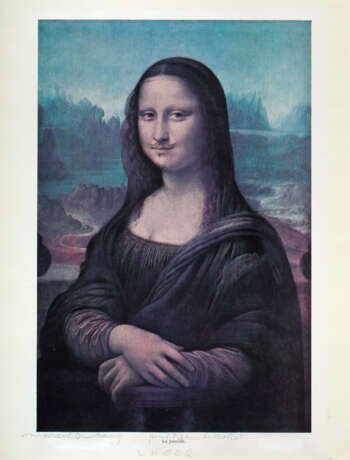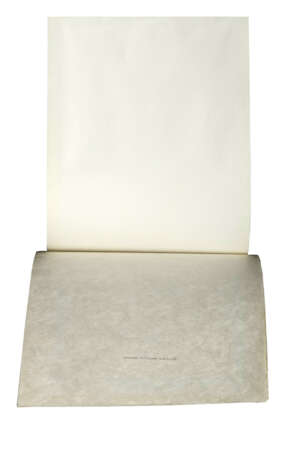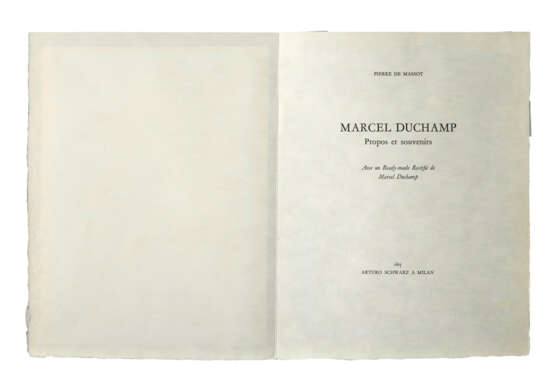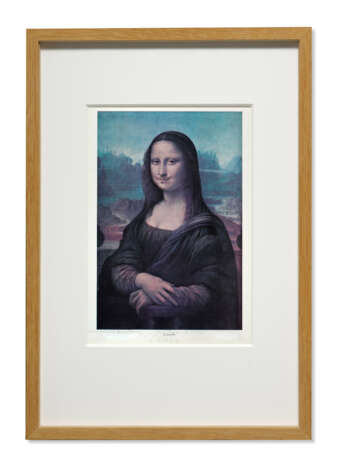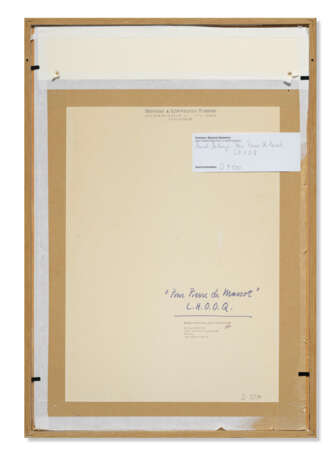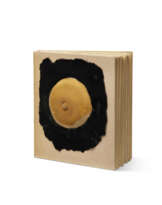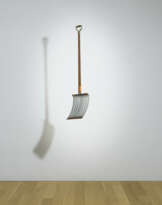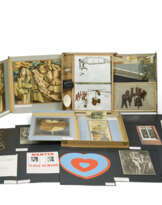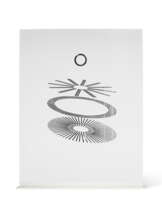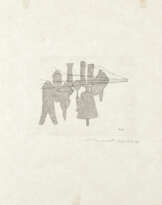ID 1053087
Los 337 | Marcel Duchamp (1887-1968)
Schätzwert
€ 500 000 – 800 000
L.H.O.O.Q.
signé et inscrit 'Marcel Duchamp Pour Pierre de Massot L.H.O.O.Q.' (le long du bord inférieur)
graphite sur une reproduction en couleurs de La Joconde
30.1 x 23 cm.
Exécuté à Neuilly-sur-Seine en septembre 1964 dans une édition numérotée de 35 exemplaires plus 3 exemplaires non-numéroté pour l’artiste, Pierre de Massot et Arturo Schwarz
signed and inscribed ‘Marcel Duchamp Pour Pierre de Massot L.H.O.O.Q.' (along the lower edge)
pencil on a color reproduction of the Mona Lisa
11 7⁄8 x 9 in.
Executed in Neuilly-sur-Seine in September 1964 in a numbered edition of 35 examples plus 3 unnumbered examples for the artist, Pierre de Massot and Arturo Schwarz
Provenance
Pierre de Massot, Paris.
Carl Fredrik Reuterswärd, Suède (probablement acquis auprès de celui-ci à la fin des années 1960).
Don de celui-ci au propriétaire actuel en 2001.
Literature
P. de Massot, Marcel Duchamp, Propos et Souvenirs, Milan, 1965.
A. Schwarz, The Complete Works of Marcel Duchamp, New York, 1970, p. 476-477, no. 261e (une autre version illustrée, p. 476).
F. M. Naumann, Marcel Duchamp, The Art of Making Art in the Age of Mechanical Reproduction, New York, 1999, p. 248, no. 8.75 (une autre exemplaire illustrée en couleurs).
A. Schwarz, The Complete Works of Marcel Duchamp, New York, 2000, vol. II, p. 670-671, no. 369f (une autre version illustrée, p. 670).
F. M. Naumann, The Recurrent, Haunting Ghost, Essays on the Art, Life and Legacy of Marcel Duchamp, New York, 2012, p. 89 (un autre exemplaire illustré en couleur, fig. 8.11).
Exhibited
(prêt long terme) Hanovre, Sprengel Museum (depuis 2011).
Hanovre, Sprengel Museum, Gegeben sind Reuterswärd Fahlström Duchamp, mars-juin 2022, no. 63 (illustré en couleurs).
Further details
L.H.O.O.Q. de Marcel Duchamp occupe une place essentielle et tout à fait particulière dans l'histoire de l'art du XXe siècle, ne serait-ce que pour les impertinentes initiales inscrites en lettres majuscules dans sa partie inférieure, proclamant haut et fort tout l'esprit iconoclaste dada. L'oeuvre d'origine voit le jour en 1919 sur une simple carte postale, une reproduction de La Joconde de Léonard de Vinci que l'artiste agrémente d'une moustache et d'un bouc. Une mention griffonné à la va-vite, et le tour est joué : quelques coups de crayon auront suffi à créer une toute nouvelle image, une œuvre d'art à part entière dont Duchamp se présente comme l'auteur. La portée subversive de ce readymade retouché avec humour est évidemment démultipliée par le jeu de mots sulfureux qui réside dans son titre, L.H.O.O.Q. : allographe de « Elle a chaud au cul », ou, comme le traduira plus élégamment Duchamp dans la langue de Shakespeare : «There is a fire down below » (M. Duchamp, ‘Interview with Hubert Crehan for WBAJ-FM Radio, New York’, paru in Evidence, no. 3, Toronto, automne 1961, pp. 36-38). Duchamp reviendra plusieurs fois sur ce thème, signant au cours de sa vie sept éditions différentes de L.H.O.O.Q., qui demeure encore à ce jour l'une des images les plus emblématiques et retentissantes de sa carrière.
« La Joconde était tellement célèbre et admirée de tous qu'il était très tentant d'en faire l'objet d'un scandale » (M. Duchamp, in C. Tompkins, The Bride and the Bachelors: Five Masters of the Avant-Garde, New York, 1968, p. 45). Accroché aux cimaises du Louvre depuis 1804, le chef-d'œuvre de Léonard connaît en effet un regain d'intérêt à la suite de son cambriolage sensationnel en août 1911. L'événement fait la Une des journaux du monde entier ; la notoriété de La Joconde est à son comble. La police n'a pas de pistes, l'enquête stagne ; même Guillaume Apollinaire et Pablo Picasso figurent sur la liste des suspects. De quoi faire couleur beaucoup d'encre : durant plusieurs mois, les médias français se livrent à une surenchère de faits divers, se ruant sur les faux témoignages et la moindre théorie du complot. Si bien que, lorsqu'elle est enfin retrouvée plus de deux ans plus tard, la figure de la Joconde est devenue l'une des icônes les plus célèbres de la culture populaire française. La preuve s'il en fallait : dans les jours qui suivirent la reprise de ses fonctions, plus de cent mille curieux seraient venus lui rendre hommage au Louvre.
Le quatre-centième anniversaire de la mort de Léonard de Vinci en 1919 marque un engouement renouvelé pour la vie et l'œuvre de l'Italien, largement perçu comme la quintessence du peintre de génie dans les milieux artistiques parisiens. Pour Duchamp, ce contexte sera l'occasion parfaite pour mettre, avec L.H.O.O.Q., un coup de pied dans la fourmilière en désacralisant avec ironie l'œuvre la plus vénérée du maître. D'autres l'ont précédé ; sa Joconde travestie s'inscrit dans une longue lignée de détournements. L'une des premières appropriations dont on ait gardé la trace date de 1887 : imaginée par un illustrateur du nom de Sapeck (pseudonyme d'Eugène Battaille), elle représente Mona Lisa fumant une pipe. En 1914, Kasimir Malevitch s'attaque à son tour au culte de Léonard en glissant une reproduction du chef-d'œuvre dans un collage, Composition à La Joconde, qu'il oblitère de deux grands « X » rouges. De nombreux autres pastiches succèderont à la version de Duchamp, le plus célèbre restant sans doute la série de toiles (Mona Lisa, 1963, et ses variations ultérieures) qu'Andy Warhol produit en 1963, lors du séjour de La Joconde à la National Gallery of Art de Washington.
Proche du graffiti, l'intervention de Duchamp soulève par ailleurs des questions liées à l'identité de genre et à la versatilité des apparences, sur lesquelles son œuvre joue si volontiers. « Ce qui est curieux avec cette moustache et cette barbiche, fera-t-il remarquer, c'est qu'en la regardant, soudain la Joconde a l'air d'un homme : pas d'une femme déguisée en homme, mais d'un homme, un vrai ; voilà ce que j'avais révélé au grand jour, sans même le savoir à l'époque » (M. Duchamp, in C. Tomkins, Duchamp, A Biography, New York, 1996, p. 222). Cette Joconde à moustache peut être perçue comme le pendant de l'alter-égo féminin de l'artiste : Rrose Sélavy (à prononcer « Eros, c'est la vie »), immortalisée par un portrait-photo de Man Ray où l'on voit Duchamp, transformé en coquette par un peu de maquillage et un simple chapeau, l'œil rivé sur l'objectif d'un air aguicheur.
S'il se retire officiellement du monde de l'art bien avant les années 1960 pour se consacrer entièrement aux échecs, dans son grand âge Duchamp autorise de temps à autre la réédition d'œuvres de sa jeunesse. En 1964, Arturo Shwarz, historien de l'art et ami proche de l'artiste, organise la publication de Marcel Duchamp, propos et souvenirs : un court essai, très poétique, écrit par l'écrivain Pierre de Massot. Pour agrémenter cette édition de trente-cinq exemplaires, Shwarz demande à Duchamp de lui fournir une illustration : il choisira L.H.O.O.Q.. Duchamp se procure trente-huit reproductions en couleur de La Joconde (dont trois éditions hors commerce pour Schwarz, Massot et lui-même), qu'il travestit ensuite selon son habitude : une moustache, des poils au menton, quelques initiales et une fine couche de gouache blanche pour dissimuler les noms de l'auteur du tableau et du musée auquel il appartient. Avec ce geste tout simple, Duchamp désavoue l'identité de l'original et affirme, du même coup, le statut de L.H.O.O.Q. : une œuvre d'art tout ce qu'il y a de plus légitime, sans dieu ni maître.
Marcel Duchamp’s L.H.O.O.Q holds an important place within the history of twentieth century art, its simple, graffiti-like markings acting as a bold proclamation of DADA’s irreverence towards tradition. Originally executed in 1919 using a cheap postcard reproduction of Leonardo da Vinci's famed Mona Lisa, Duchamp drew a moustache and goatee on the sitter’s face, presenting the new image as an independent artwork in its own right. The shocking and subversive impact of this humorously altered readymade was accentuated through the phonetic pun nestled within its title, which the artist wrote on the edge of the card. When read aloud in French, L.H.O.O.Q. mimics the phrase “Elle a chaud au cul,” which translates as “She has a hot ass,” or as Duchamp himself stated, “There is a fire down below” (M. Duchamp, ‘Interview with Hubert Crehan for WBAJ-FM Radio, New York’, published in Evidence, no. 3, Toronto, Fall 1961, pp. 36-38). One of the most recognizable and influential works within his oeuvre, Duchamp returned to the Mona Lisa as the subject for seven distinct iterations of L.H.O.O.Q. throughout his life.
“The Gioconda was so universally known and admired”, Duchamp later explained about his choice of subject, “it was very tempting to use it for scandal…” (M. Duchamp, quoted in C. Tompkins, The Bride and the Bachelors: Five Masters of the Avant-Garde, New York, 1968, p. 45). Indeed, though the painting had been hanging in the Louvre since 1804, its renown within the public consciousness had reached new heights following its audacious theft from the museum in August 1911. The event quickly made headline news around the world, and though both Guillaume Apollinaire and Pablo Picasso were considered suspects in its disappearance, the police remained baffled by the crime. The case was reported widely in the French media over the following months, with every rumored sighting and new conspiracy theory picked over by commentators. By the time of its recovery over two years later, the Mona Lisa was among the most instantly recognizable icons in French culture – in the days immediately following its return to the Louvre, over a hundred thousand people are said to have visited the painting, welcoming her back to the city.
Events marking the four hundredth anniversary of Da Vinci's death created a lively discourse around his life and work in Parisian art circles over the course of 1919. Well aware of this context, Duchamp used L.H.O.O.Q. to puncture the cult of reverence surrounding the artist, taking aim at the Renaissance master’s most recognizable artwork. In so doing, Duchamp took his place in a long lineage of artistic commentary on the celebrated painting. One of the earliest known appropriations appeared in 1887 when an illustrator known as Sapeck (Eugène Battaille) depicted the famous lady smoking a pipe. In 1914, Kasimir Malevich produced a scathing commentary on the cult status that the painting had achieved, including a reproduction of the work in his collage Composition à La Joconde which he then defaced by placing a large red X over her visage. Further appropriations would follow Duchamp’s own version, perhaps the most famous of which was the series of silkscreens produced by Andy Warhol (Mona Lisa, 1963, and later variations) inspired by the painting’s visit to the National Gallery of Art, Washington D.C. in 1963.
Duchamp’s graffiti-like markings also tapped into the artist’s ongoing play with notions of gender identity and the fluidity of appearances. As he remarked: “The curious thing about that moustache and goatee is that when you look at the Mona Lisa it becomes a man. It is not a woman disguised as a man; it is a real man, and that was my discovery, without realizing it at the time” (M. Duchamp, quoted in C. Tomkins, Duchamp, A Biography, New York, 1996, p. 222). The mustached Joconde can be interpreted as being a direct parallel to the artist’s own female alter ego, Rrose Sélavy (pronounced “Eros, c’est la vie”), immortalized in a photograph by Man Ray in which the simple addition of a hat and makeup allows Duchamp to transform into a woman, glancing up coquettishly at the viewer through the camera lens.
Although officially “retired” and fully devoted to chess by the 1960s, Duchamp had on several occasions granted permission to reproduce works from his early career in new contexts. In 1964, the artist’s close friend and scholar, Arturo Schwarz, arranged the publication of a brief, yet poetic, essay on Duchamp by the French writer Pierre de Massot entitled Marcel Duchamp, propos et souvenirs. With the aim of producing a limited edition of thirty-five copies, Schwarz requested that Duchamp provide an artwork to accompany the text. The artist chose L.H.O.O.Q. for the project, purchasing 38 color reproductions of the painting (allowing for three examples outside the edition: one for Schwarz, one for Massot and one for himself), which he then altered by adding the customary facial hair as well as a thinly applied white gouache to conceal the name of the author of the original artwork and the institution where it resides. With this simple act, Duchamp negates the identity of the original painting and declares L.H.O.O.Q. as an independent artwork in its own right.
Sale room notice
L'Association Marcel Duchamp a confirmé l'authenticité de l'oeuvre.
The Association Marcel Duchamp has confirmed the authenticity of this work.
| Künstler: | Marcel Duchamp (1887 - 1968) |
|---|---|
| Angewandte Technik: | Bleistift |
| Material: | Acrylglas, Kunststoff |
| Künstler: | Marcel Duchamp (1887 - 1968) |
|---|---|
| Angewandte Technik: | Bleistift |
| Material: | Acrylglas, Kunststoff |
| Adresse der Versteigerung |
CHRISTIE'S 9 Avenue Matignon 75008 Paris Frankreich | ||||||||||||||
|---|---|---|---|---|---|---|---|---|---|---|---|---|---|---|---|
| Vorschau |
| ||||||||||||||
| Telefon | +33 (0)1 40 76 85 85 | ||||||||||||||
| Fax | +33 (0)1 40 76 85 86 | ||||||||||||||
| Nutzungsbedingungen | Nutzungsbedingungen | ||||||||||||||
| Versand |
Postdienst Kurierdienst Selbstabholung | ||||||||||||||
| Zahlungsarten |
Banküberweisung | ||||||||||||||
| Geschäftszeiten | Geschäftszeiten
|
